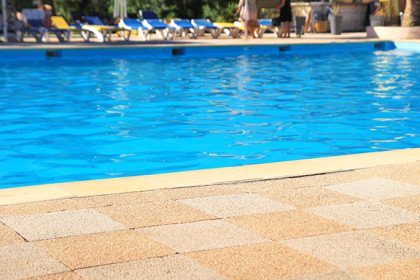Avoiding Suction Entrapment

Wednesday, May 15, 2024
Last month, an eight-year-old girl died in a suction-entrapment incident at a hotel in Houston. As reported earlier, the child disappeared while swimming in the hotel’s lazy river. She eventually was found in a pipe.
The cause is yet to be determined, but it is worthwhile to review the issue of entrapment, how it happens, ways to avoid it, and the requirements in the Virginia Graeme Baker Pool and Spa Safety Act (VGBA), the federal law mandating entrapment-prevention measures on all commercial pools and spas.
What is suction entrapment?
When a drain or other suction outlet becomes completely blocked by an individual, creating a seal, then water can no longer move through the line. This causes the low pressure at the pump impeller, called suction, to lengthen until it reaches the drain and holds down the person.
There are five types of entrapment. Some result from suction, while others happen when something becomes caught.
• Body entrapment: The torso or other large area completely covers the opening, causing suction strong enough to adhere the skin.
• Limb entrapment: An arm or leg gets stuck in the drain pipe as a result of the cover being missing or broken.
• Evisceration: The swimmer’s backside completely covers the drain, causing strong suction to form. This traps the person in place, and the suction can be strong enough to cause the intestines to exit the body.
• Hair entrapment: Hair wraps around a component of a drain or enters the suction pipe, restricting flow and trapping the individual.
• Mechanical .entrapment: Like hair entrapment, but involving objects attached to an individual, such as jewelry or a bathing-suit strap.
What prevents entrapment?
Pump suction systems and their components must be designed and installed to prevent excessive suction at any drain, and keep hair and other items from getting tangled in them.
This requires a number of measures. First, a physical separation must be maintained between swimmers and the pipe opening, with the use of code-compliant drain covers. These are designed and tested to prevent a body from completely covering the drain and forming a seal, and they have stated flow limits to prevent hair and other objects from wrapping in them. They are manufactured to withstand pool and spa conditions, including sunlight, but only for a limited time.
Next, there must be a system in place that allows water to move through the suction-side plumbing should a blockage occur. Most common are dual main drains, whereby each drain pipe has two suction outlets installed as specified by the federally regulated drain cover installation instructions and in the governing code or standard. If one becomes blocked, the other can continue pulling water. They sit 3 feet apart or can be on two surfaces, such as a floor and wall, so they can't both be blocked at once. Large, “unblockable” drains also are allowed. Pools with a single "blockable" drain must be supported by other devices allowed in the law.
What is required by the VGBA?
Since Dec. 19, 2008, every single commercial swimming pool in the U.S. must have suction outlet covers that comply with the most recent standard approved by the Consumer Product Safety Commission for the VGBA. Currently that is ANSI/APSP/ICC-16 2017 American National Standard for Suction Outlet Fitting Assemblies (SOFA) for Use in Pools, Spas and Hot Tubs.
So-called drainless pools are exempt. Custom fabricated drain covers can be designed and certified by a Registered Design Professional under certain conditions.
Suction outlet covers must be installed and maintained according to manufacturer instructions.The designer or builder must choose the covers based on their certified flow rate based on the suction-pipe opening size. Manufacturers will provide a maximum flow rate, stated in gallons per minute. The gpm at each drain cover must fall below that flow rating. The manufacturer also must stipulate certain dimensions, such as the depth of the sump, the space between the outlet cover and suction pipe opening.
Factors such as pool chemistry and ultraviolet light can affect the durability of the materials used to make and fasten the covers. They must be replaced at the end of their lifespan, as defined by the manufacturer. The service life clock begins when a drain cover is installed. Further, facilities must record when covers are installed or replaced, as well as the lifespan.
VGBA also mandates that commercial pools have compliant multi-drain systems or an unblockable drain. If only a single blockable drain is present, an approved secondary device or system designed to prevent suction entrapment is needed to prevent, limit, or release the suction formed by a blockage. These include safety vacuum release systems (SVRS), suction-limiting vent systems, gravity drainage systems, or automatic pump shut-off systems.
What other Laws, codes or standards apply?
Many states and municipalities have passed laws or codes based on language provided in industry standards and model codes.
Even in the absence of those, professionals are advised to consult with the Model Aquatic Health Code and PHTA standards such as ANSI/PHTA/ICC-7 2020 American National Standard for Suction Entrapment Avoidance In Swimming Pools, Wading Pools, Spas, Hot Tubs and Catch Basins for more in-depth guidance on fully submergped suction outlet systems.